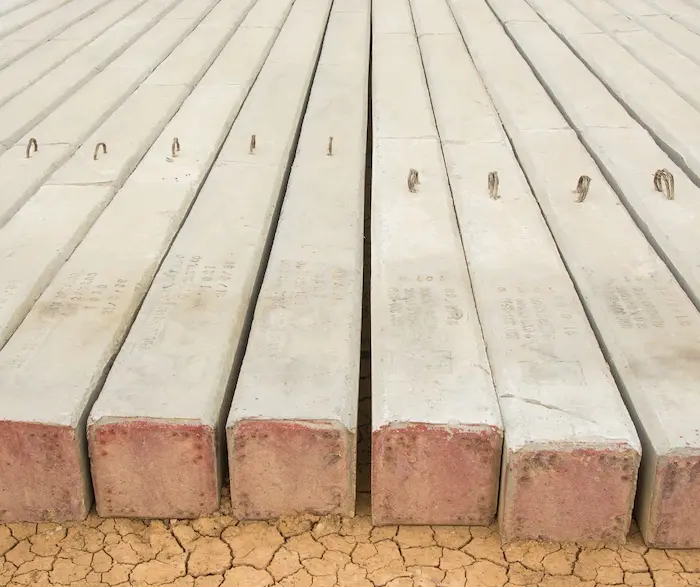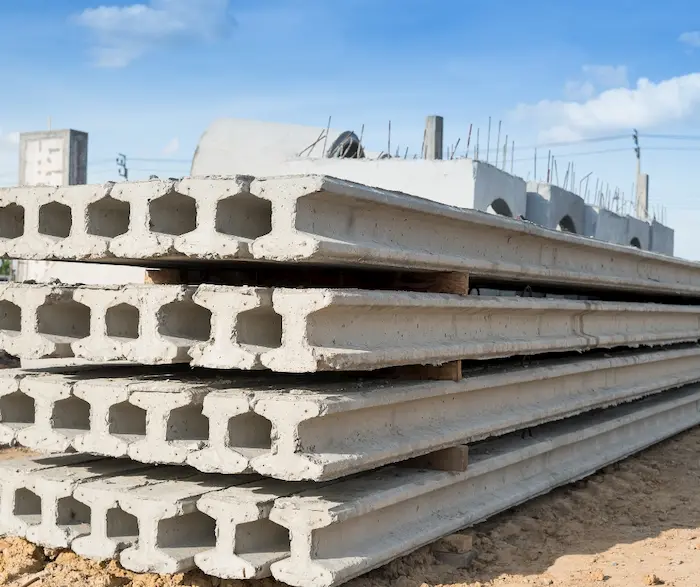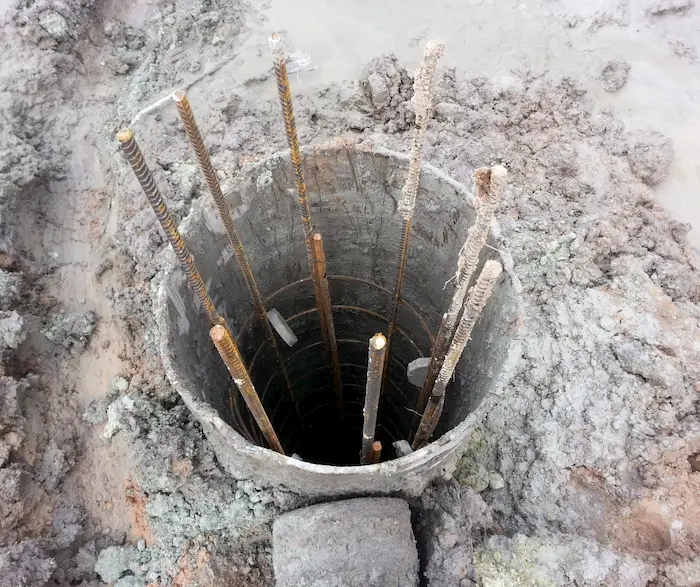Concrete piles are a crucial component of foundation systems used in construction projects worldwide. They provide a stable and secure base for buildings, bridges, and other structures, ensuring their longevity and safety. There are various types of concrete piles available, each with unique advantages and disadvantages.
In this article, we will explore the different types of concrete piles, their installation methods, and their suitability for different soil conditions and loading conditions. Whether you are a construction professional or simply interested in the world of construction, this article is an informative guide to the essential foundation system components – concrete piles.
To begin with, let’s take a moment to learn what is a concrete pile.
Definition of Concrete Piles

Concrete piles are a type of foundation element used in construction to transfer the loads from the structure to the underlying soil or rock. They are cylindrical in shape and are typically made of reinforced concrete, which provides strength and durability. Concrete piles are installed by drilling a hole into the ground and filling it with concrete.
Different types of concrete piles are commonly used in large structures, such as bridges and high-rise buildings, where the weight of the structure is significant and needs to be evenly distributed to the ground. The use of concrete piles ensures a secure and stable foundation, providing a strong base for the structure to be built upon.
Why is a concrete pile needed? What is the purpose of a concrete pile? This is a big question, so let’s take a closer look at it.
Importance of concrete piles
Concrete piles play a crucial role in the construction industry as they provide a stable foundation for structures. They transfer the load of the structure to the underlying soil or rock, ensuring the stability and safety of the building. Concrete piles are essential in areas where the soil is not strong enough to support the weight of the structure. They can be used to support a range of structures, including bridges, buildings, and industrial facilities.
Different types of concrete piles also provide resistance to lateral forces, such as wind or earthquakes, which can cause the building to sway or even collapse. They ensure the building remains stable and can withstand the forces of nature. In addition, concrete piles can be designed to resist corrosion, fire, and other hazards, making them a reliable and long-lasting foundation solution.
Overall, the importance of different types of concrete piles cannot be overstated, as they are essential in ensuring the safety and stability of structures in a wide range of construction projects. They provide a strong and durable foundation that can withstand the forces of nature, ensuring the longevity of the structure and the safety of those who use it.
If you ask how many types of concrete piles are there let’s learn the concrete pile’s classification based on several factors.
Classification of Concrete Piles
Concrete piles are classified based on several factors such as the method of installation, shape, size, and material used.
Based on Installation Method
Concrete piles can also be classified based on their installation method. The three main types of concrete piles are:
Driven Piles:
Driven piles are installed by hammering them into the ground using a pile driver. The piles can be precast or cast-in-place, and they are often made of reinforced concrete. Driven piles are suitable for sites with cohesive soils and can be driven to significant depths. They are an economical choice for sites with easy access.
Bored Piles:
Bored piles are installed by drilling a hole into the ground and then filling it with concrete. The reinforcing steel bars or cages are placed in the hole before the concrete is poured to provide additional strength. Bored piles are suitable for sites with hard or rocky soil conditions and can be drilled to significant depths. They are also an excellent choice for sites with limited access.
Drilled Piles:
Drilled piles are installed by drilling a hole into the ground and then placing a steel reinforcement cage in the hole. The concrete is then poured into the hole to create the pile. Drilled piles are suitable for sites with soft soil conditions and can be drilled to significant depths. They are an excellent choice for sites with limited access or where noise and vibration need to be kept to a minimum.
The choice of installation method for different types of concrete piles depends on the specific site conditions, access to the site, and the requirements of the structure being built.
Based on Material
Here are the different types of concrete piles based on the material used:
Pre-cast concrete piles:
Pre-cast concrete piles are manufactured in a factory and transported to the construction site. These piles are made by casting concrete in a steel mould and are available in different shapes, sizes, and lengths. They are commonly used in areas with difficult soil conditions and high structural loads.
Cast-in-situ concrete piles:
Cast-in-situ concrete piles are made by pouring concrete into a pre-drilled hole in the ground. The hole is typically lined with a steel casing to prevent the soil from collapsing during the pouring process. These piles are commonly used in areas with a high water table.
Composite piles:
Composite piles are made by combining two or more materials, such as concrete and steel, to create a stronger and more durable pile. The concrete provides structural support while the steel adds strength and flexibility.
Prestressed concrete piles:

Prestressed concrete piles are made by pre-tensioning steel wires or cables before casting the concrete. This process allows the pile to withstand higher loads and provides better resistance to lateral forces. They are commonly used in areas with high seismic activity.
Reinforced concrete piles:
Reinforced concrete piles are made by adding steel bars or mesh to the concrete before casting. This reinforcement adds strength and durability to the pile, making it suitable for areas with high structural loads.
Based on Shape and Size
Here is the classification of different types of concrete piles based on their shape and size:
Cylindrical Piles:
Cylindrical piles have a circular cross-section and are commonly used in soft soil conditions where they can be driven to great depths. They are available in a variety of sizes ranging from small diameter piles of around 150mm to large diameter piles of over 1m.
Square Piles:
Square piles have a square cross-section and are commonly used in hard soil conditions where they can be driven to great depths. They are available in various sizes ranging from small piles of around 150mm to large piles of over 1m.
Rectangular Piles:
Rectangular piles have a rectangular cross-section and are commonly used in construction projects where space is limited. They are available in various sizes and can be used in both soft and hard soil conditions.
Tapered Piles:
Tapered piles have varying cross-sections and are commonly used in situations where the soil conditions change over the depth of the pile. They are available in different sizes and are suitable for both soft and hard soil conditions.
Composite Piles:
Composite piles have a combination of different shapes and sizes and are used to overcome the limitations of individual pile types. They are made by combining different materials and are commonly used in areas with difficult soil conditions.
Let’s take a look at some of the advantages of different tconcrete piles now.
Advantages and Disadvantages of Each Types of Concrete Piles
A. Driven Piles – Advantages:
- Ideal for dense soil conditions
- Can support heavy loads
- Quick installation
- Disadvantages:
- Produces noise and vibration
- Can be challenging to install in certain areas
- Requires specialized equipment
B. Cast-in-Place Piles – Advantages:
- Ideal for difficult access areas
- No noise and vibration during installation
- Can be installed to significant depths
- Disadvantages:
- Requires significant excavation
- Difficult to verify pile alignment
- Time-consuming installation process
C. Pre-cast Concrete Piles – Advantages:
- Minimal noise and vibration during installation
- Can be manufactured off-site
- Consistent quality
- Disadvantages:
- Limited length
- Transport can be challenging
- Higher cost than cast-in-place piles
D. Cast-in-Situ Piles – Advantages:
- Ideal for areas with limited access
- Can be installed to significant depths
- Minimal noise and vibration during installation
- Disadvantages:
- Requires significant excavation
- Time-consuming installation process
- Difficult to verify pile alignment
Factors Affecting When Selection of Concrete Piles

The selection of concrete piles for a construction project is critical for ensuring the long-term stability and safety of the building or structure. Various factors should be considered when selecting the appropriate type of pile for a specific project. Here are some factors affecting the selection of concrete piles:
Soil Conditions:
The soil conditions at the construction site play a significant role in determining the type of pile to be used. For example, if the soil is soft or unstable, longer piles may be required to reach a more stable layer of soil. Similarly, if the soil is hard, shorter and wider piles may be used.
Structural Loads:
The weight of the structure to be built and the loads it will support are essential factors to consider when selecting concrete piles. Heavy structures require larger and stronger piles to provide adequate support.
Environmental Factors:
Environmental factors such as the water table level, ground surface conditions, and the presence of corrosive materials can also affect the selection of concrete piles. For example, if the water table is high, longer piles with a larger diameter may be used to prevent the piles from being affected by the water.
Availability and Cost of Materials:
The availability and cost of materials used for making the concrete piles can also affect their selection. The availability of materials may vary depending on the location of the construction site, and the cost of the materials can impact the project budget.
Installation Method:
The installation method of different types of concrete piles can also affect their selection. Different pile types have different installation methods, and some methods may not be suitable for certain soil conditions or structural loads.
Final Verdict
In conclusion, the various types of concrete piles provide a wide range of options for engineers to choose from, based on the specific soil conditions and structural loads of a construction project. Each type of pile has its advantages and disadvantages and can be tailored to suit the unique needs of a project.
Pre-cast concrete piles are ideal for sites with limited access or where noise and vibration must be kept to a minimum during installation. Cast-in-situ concrete piles are suitable for larger projects, where economies of scale can be realized due to the use of a larger construction team.
Therefore, the use of different types of concrete piles remains a vital element in the construction industry, providing the necessary foundation support for a wide range of buildings and structures. With continued innovation in materials and installation methods, concrete piles are expected to remain a preferred choice for engineers worldwide.
Frequently Asked Question
What are the advantages of using precast concrete piles?
Precast concrete piles can be manufactured offsite, ensuring quality control and reducing the need for extensive onsite labor. They are also ideal for sites with limited access or where noise and vibration must be minimized during installation.
What are the disadvantages of using cast-in-situ concrete piles?
Cast-in-situ concrete piles can be more expensive than precast piles due to the larger construction team required for installation. They are also not suitable for sites with limited access or where noise and vibration must be kept to a minimum.
What are composite piles, and when are they used?
Composite piles are a combination of different materials and shapes, allowing them to overcome the limitations of individual pile types. They are commonly used in sites with complex soil conditions or where the required load capacity is beyond the range of a single pile type.
What are the most commonly used shapes and sizes of concrete piles?
Cylindrical, square, rectangular, and tapered piles are the most commonly used shapes of concrete piles, along with composite piles. The size of the pile is typically determined by the soil conditions and structural loads of the construction project.
What type of concrete pile is ideal for larger structures with heavier loads?
Prestressed and reinforced concrete piles are ideal for larger structures with heavier loads, providing greater strength and durability than other pile types.
